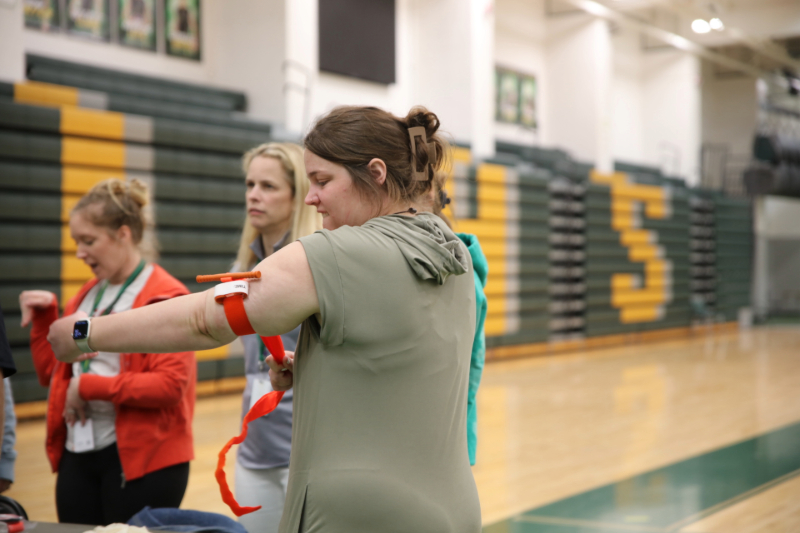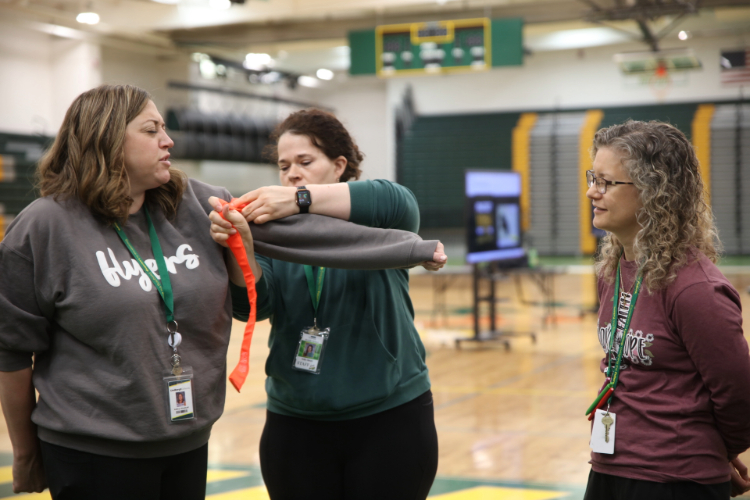The Mehlville Fire Protection District’s Mobile Integrated Health (MIH) Department taught Lindbergh School District educators bleeding control techniques – such as how to pack a wound, how to apply a tourniquet and how to best apply first aid during emergencies in a school environment – through an interactive course April 26.
The course was taught by MIH Director Jenny Rieker who was assisted by Community Paramedic Nick Marty. The duo began by sharing some facts with the crowd, such as bleeding being the No. 1 preventable cause of death in a trauma.
“If the trauma doesn’t kill somebody, the bleeding out afterwards absolutely can, and in most cases (it) is what causes death,” Rieker said. “Bleeding enough to actually cause death can happen in minutes, depending on what part of the body and blood vessel has been injured. That’s why it’s so important to know what to do and to act fast.”
Because of the topic, Rieker acknowledged that most of the educators in attendance were likely envisioning the worst-case scenario – some violent act – as the cause of bleeding in a school setting. She assured them that while that fear is not unjustified, there are a variety of other day-to-day circumstances where bleeding could occur that are far more likely.
“Violent acts are the thing that’s in our mind pretty prevalently, but there’s so many other ways that bleeding can happen. It can happen with pencils, it can happen from an injury or bone break, it can happen at home if you’re doing home improvement,” Rieker said. “You can have an injury that’s bad enough in any sport that can cause bleeding. You can have weather events, vehicle accidents, hiking – all these things are reasons why it’s really important to have this information, not just for the school setting, but for all the time.”

She next shared what to do in an emergency bleeding situation, simplifying things with a memorable acronym: ABC.
“Paramedics, we love easy ways to remember things, we love mnemonics. So for this one, we’re going to use ABC, the easiest mnemonic to remember,” Rieker said. “A stands for ‘Alert 911,’ B stands for ‘identify the bleeding’ – so bleeding assessment – and C stands for ‘bleeding control.’ So, very easy – alert, find the bleeding, fix the bleeding. Pretty easy stuff, ABC.”
Marty then took the helm, going over three bleeding control methods: applying pressure, packing the wound and applying a tourniquet. Applying pressure is self-explanatory, though Marty emphasized the importance of using your entire upper-body weight as pressure when treating adults to initiate the clotting process to stop the bleeding from continuing. When treating children, less weight is needed as their bodies are smaller, though pressure should still be firm.
“Sometimes when they’re bleeding in the armpit or the groin or the neck, it can be really difficult to figure out where the bleeding is coming from, so you may have to clean the area. Once you’ve located the source of the bleeding, you will take your bandage or t-shirt or whatever thing that you can use for bleeding control, and apply that pressure,” Marty said. “We place it right over the top, we push down on it, and we hold it in place for as long as we need to, until help arrives. In general, help should be there within 10 minutes.”
He said the bandage should always be left on, even if it is bled through.
“We will leave it on and then we will take another bandage and we’ll put it right on the top. If it continues to bleed past this, we should start considering using a tourniquet. Occasionally the bleeding may be insidious or they could have been bleeding long enough that the bleeding has slowed down to a point where we can’t tell the difference between venous and arterial, so a tourniquet may be needed,” he said.
Before applying a tourniquet, however, packing the wound – if able and necessary – should be done.
“We will take the tail end of our bandage, and then we’ll take it, and we’ll begin packing the wound. This part is, I would say, the grossest of them because you have to sort of stick your fingers into the hole and you have to fill the cavity with the gauze,” Marty said. “You’re gonna have to use your fingers to tuck as much of this bandage into the wound as possible. The important part about this is you’re going to have to keep holding pressure as you’re packing the wound.”
Finally, applying a tourniquet was discussed. The skin must be bare to apply a tourniquet, so any excess clothing in the affected area must be removed. The tourniquet should be placed several inches above the wound and tightened with the buckle. If using a makeshift item as a tourniquet, a knot can be used to tighten it, though the item used for the improvised tourniquet must be somewhat wide so as not to cause harm.
A windlass rod — or a similar item, such as a pen — is used to secure and further tighten the tourniquet. The windlass should only be twisted at most two times; if it can be twisted more, the process must be restarted to ensure that it works. The windlass is then secured, and the process ends the same as those mentioned above, waiting for help.
“The important thing to note about applying a tourniquet is they hurt,” Marty said. “People do not like when you put tourniquets on them. Every tourniquet I’ve applied to a person, they’ve screamed at me. A child doesn’t quite understand why you’re doing this – you will have to reassure them. You will have to tell them ‘I have to do this in order to help you.’”
After the presentation, the educators practiced their new knowledge in stations, packing holes in foam blocks with gauze and applying tourniquets to themselves and their peers.
“This training is so valuable because like we talked about, it is real life,” said Jessica Parker, a P.E. and health teacher at Sperreng Middle School. “We are working with humans, we’re working with different people, and injuries can happen, accidents can happen. That is real life, so knowing what to do when we are in those life-threatening and emergency situations when your adrenaline is pumping, and a lot of that instant reaction training can kind of be lost in the shuffle, we are trained to know what to do exactly on the spot when you could possibly forget.”



